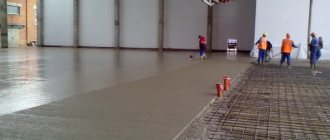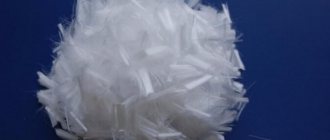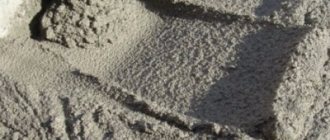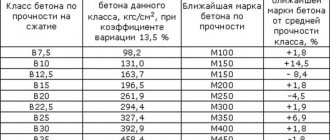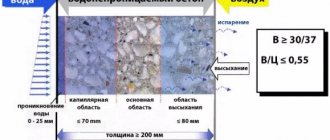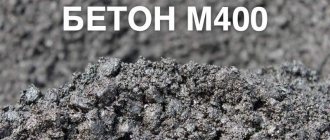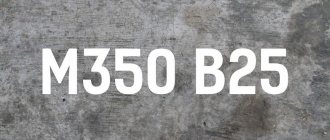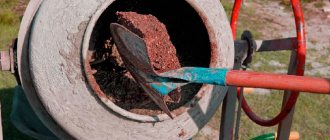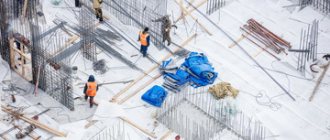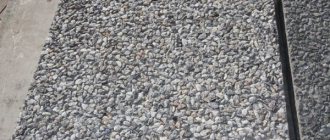Destructive effect of water
Making concrete waterproof with your own hands is not difficult. But before this, you should know for what purpose all this is used. To make it waterproof means to waterproof it.
Waterproofing can be of different types: pasting, coating, using roll materials.
Waterproofing a concrete foundation must be carried out using one of the methods in order to prevent early destruction of the building structure.
In addition, it is carried out both at the stage of laying the foundation and during its operation. Its main goal is to ensure the hygroscopicity of the foundation. The outermost one is laid below the ground level, as a result of which it comes into contact with groundwater. How can water damage concrete?
This will certainly happen within a couple of years or even decades. The bad one has the ability to absorb water because it has micropores. In the winter season, the water freezes, and at the same time its volumes increase sharply in size. As a result, the pores expand and cracks may appear. The next year, water again enters the micropores, but in huge quantities. Thus, every year the concrete absorbs more and more water and is evenly destroyed. In addition, water can seep into the foundation of the building.
Brand meaning
Waterproofing of concrete can be carried out both at the stage of making the consistency, and with the help of special protective agents applied to the hardened concrete surface.
You can make concrete waterproof with your own hands, knowing that its characteristics are influenced by the quality of the initial raw materials. Water resistance is based on the so-called water-cement ratio, which directly depends on the water content in concrete and the brand of cement used. As the amount of cement increases, the water-cement ratio decreases. This ensures that the concrete does not delaminate, increases its strength and, as a result, resistance to water. The brand of cement itself is of great importance. Almost always, manufacturers do not use expensive cement, since it is not profitable.
Finely ground cement is ideal for these purposes, as it promotes the formation of the smallest pores that are moderately distributed over the entire size and reduces the sedimentation of particles. An increased water content increases filtration and thereby increases the water load. Portland cement became extremely widespread. Based on these data, we can say: the lower the water-cement ratio in concrete, the better.
About waterproof concrete
Concrete with a high coefficient of water resistance is a heavy type of material. It is used for the construction of wells, swimming pools, bridges, and other specific objects that are often in contact with water and other liquids. In addition, the products are subject to high requirements for frost resistance and compressive strength.
The waterproof property is the actual ability of a hardened material to resist the passage of moisture under the influence of fluid pressure. This parameter in technical and operational properties is designated by the letter W. It corresponds to the standard classification within the range of values 2-20, which corresponds to the pressure (MPa) at which a fragment of concrete with a height and diameter of 15 centimeters withstands water pressure and does not allow liquid to pass through itself.
Painting waterproofing
Painting waterproofing of concrete is a rather complicated and labor-intensive process that requires the use of special equipment. This method is often used in the construction of large industrial facilities.
Concrete can be made waterproof by introducing surfactants. They form a waterproof layer (film) on the concrete surface. These substances are applied using special equipment: pistols, sprayers. Most often, bitumen, mastics, emulsions and other consistencies heated to high temperatures are used. Some of them are not able to withstand low temperatures and often become covered with cracks. To give concrete special parameters, its surface is painstakingly processed and cleaned before applying the painting material.
Then a layer of paint or any other consistency is applied, its thickness may vary, on average several mm. A layer of primer is placed on it. Currently, hydrophobic mixtures based on organosilicate compounds have found widespread use. But they do not completely close the pores in concrete, and therefore are vital only for protection from precipitation and low water pressure. Fluates, salts of fluoric acid, are also highly effective. But they are only suitable for finely porous concrete. The introduction of bitumen mastic can have a positive result. It consists of bitumen and a mineral component (limestone, clay). Their ratio varies. The percentage of bitumen in the consistency ranges from 30 to 45%. With all this, such a coating material has the highest frost resistance.
Coating option
To waterproof concrete surfaces, they are coated with special waterproofing compounds that penetrate into the thickness of the concrete and clog the pores.
Waterproof concrete can be obtained by applying coating materials to its surface. They can be used as hot mixtures based on bitumen and mastic. To do this, it is important to prepare the concrete surface for processing. She is being cleansed. Then 2 layers of primer are applied. The first one contains a slow-acting solvent, the second one contains a fast-acting one. These layers promote the best adhesion of the coating solution and the concrete surface. The coating material is applied in 2 layers. First one, then the second. After just a couple of minutes, you can see how a special protective film appears on the concrete.
This method is better than painting because it is the strongest. But it also has a number of shortcomings. The most basic of them is that even with slight deformation of concrete and its surface, the coating can collapse. In addition, there are often cases of coating dripping. The reason for this is the incorrect selection of mastic. It is extremely important to know that the coating is applied in 2 layers, each about 2 mm thick. After applying the feather coat, you need to carefully check the quality of the coating and only then continue working.
When the cause of dampness has been established, waterproofing of concrete structures can begin.
There are so many ways to waterproof concrete structures that it’s easy to get confused. Here are brief practical recommendations for choosing waterproofing materials that change the properties of concrete, i.e. making the concrete itself a waterproofing and protective layer.
There are two main directions (classes) of how to make concrete a waterproofing and protective layer:
- Make concrete waterproof
- Make concrete waterproof
Waterproof concrete
1.1. Features of waterproof concrete
The job of waterproof concrete is to:
- or “repel” water (not get wet), which is ensured by the use of water repellents:
Photo 1. Operation of water repellent
- or do not let water inside, but if there is no high water pressure, which is ensured by partial closure of capillaries by using clogging materials in minimal dosages, or better yet, specially developed materials for partial clogging (such as Kontacid grade 3):
Photo 2. Work of Contacida brand 3
Hence the main use of waterproof (and especially hydrophobized) concrete is above the water level (i.e. protection from dampness and corrosion):
- walls in the above-ground part of the structure on the windward side;
- concrete floor in workshops, warehouses, not in contact with groundwater...
1.2. Obtaining waterproof concrete
You can get waterproof concrete:
- from a concrete mixture , for example, by introducing into it a water repellent or a bridging additive (optimized in quantity and formulation - such as Kontacid grade 3 (for highly porous concrete) or Betonoprav luxury grade 2 (for ordinary low-porous concrete));
- or by treating the existing concrete with a water repellent or bridging impregnation (optimized in quantity and formulation - such as Contacid grade 3 solution).
However, when using a water repellent, you should remember its features. Any water repellent, due to its water-repellent properties (i.e. the target effect - see photo 1), is a material that prevents:
- penetration of aqueous solutions into the substrate, incl. clogging pores;
- wetting the substrate and adhesion of water-containing solutions to it, incl. solutions based on cement, lime, gypsum, as well as water-based paints and varnishes.
Taking into account these features of water repellents, the creation of water-resistant concrete using a system of compatible materials Dehydrol, Betonoprav, Kontatsid is based on partial clogging (see photo 2). For the production of homogeneous, highly water-resistant concrete, incl. on porous aggregates, you can use the optimized additive Betonoprav lux grade 2 in an amount of 3-4 liters per cubic meter of concrete mixture. This additive also gives concrete corrosion resistance (frost resistance) and further increases its water resistance.
Example of a waterproof concrete recipe:
| Cement | Crushed stone | Sand | Concrete setter luxury brand 2 | Water |
| 490 kg | 1190 kg | 600 kg | 4 l | 170 l |
In the case of cellular concrete (foam concrete, aerated concrete), Contacid grade 3 should be used.
Waterproof concretes are not able to effectively withstand water pressure; they are resistant to splashes of water or to slight moisture, i.e., mainly dampness. If you need concrete to withstand water pressure, such as in underground structures or tanks, then you need waterproof concrete.
Waterproof concrete
The term “waterproof concrete” itself characterizes the way such concrete works and typical areas of its application - where it is necessary that water does not pass through the concrete even in the presence of water pressure:
- water intake and water treatment blocks, drinking water collectors and reservoirs, concrete filter structures, settling tanks and process water collectors, aeration tanks, cesspools, treatment plant tanks, concrete collectors;
- dams, dikes, walls and galleries in them, concrete conduits, cooling towers, fountains;
- underground and buried structures and structures (including warehouses, trading floors, basements, shelters, basement floors, underground garages, parking lots, cellars, foundations, sewage pumping stations), damp, wet and freezing walls...
To obtain waterproof concrete, methods are used to reduce its porosity, for example, clogging.
When a waterproofing additive is introduced into a concrete mixture, the entire thickness of the concrete becomes waterproof.
Example of a waterproof concrete recipe:
| Cement | Crushed stone | Sand | Dehydrol luxury brand 10-2 | Water |
| 490 kg | 1190 kg | 600 kg | 4 l | 170 l |
The main characteristic of waterproof concrete is its waterproof grade. For example, adding Dehydrol Lux grade 10-2 to a concrete mixture allows you to obtain concrete with water resistance up to grade W20.
It would seem that concrete with water resistance grade W20 can withstand 200 meters of water column without filtration - an excessive value for conventional construction, but this is not the case. The fact is that tests of concrete for water resistance in accordance with GOST 12730.5-84 (from 09/01/2019 GOST 12730.5-2018) are carried out on samples with a thickness of no more than 150 mm, and the samples are kept under a given water pressure for no more than 16 hours. This gives a common standard for determining and fixing the water resistance of concrete. Naturally, in practice, conditions may differ radically from GOST standards, in particular:
- groundwater backs up concrete basement structures in spring and autumn not for 16 hours, but tens and hundreds of times longer;
- the thickness of most foundation blocks is 400 or 600 mm, and the thickness of monolithic walls is 100 mm or more;
- concrete may contain porous (insufficiently compacted) areas...
The task of the civil engineer is precisely to take into account the complex influence of various factors and ensure the watertightness of the concrete structure.
Application of plaster
Today, plaster as a waterproofing material has been widely used in construction. It is prepared from fatty cement mixtures. It may contain various additives in its composition. Some of them help fill the pores and cracks in concrete with small particles, the rest are necessary for the formation of crystalline substances as a result of chemical reactions with concrete.
The water resistance of concrete is ensured by various additives and plasticizers, which compact the material and change its characteristics.
A special place is occupied by plasticizers or foaming agents, which reduce the water-cement ratio, change the shape of the surface and prevent the penetration of water.
Compacting additives include ceresite, cerolite, stone flour, ground sand and others.
Plasticizers contain rosin soap, wood baked, and oleates. The technique for applying the solution is as follows: first, the surface is cleaned, then, following the instructions for use, a layer of plaster more than 2.5 cm wide is applied, otherwise it will not be effective. It is extremely important to ensure good adhesion to the surface. For this purpose, the solution is applied only mechanically.
Do-it-yourself concrete additives for waterproofing
When thinking about what to add to concrete to prevent it from leaking water, you need to consider the main types of additives. They are usually divided into 3 groups: clogging, polymer, plasticizing.
Plasticizers
Such additives assume a single operating principle: when added to the mixture, they create a film-type coating that envelops cement particles and gives them the desired properties. The particles become more slippery and the concrete becomes more mobile. Some plasticizers can create an electrical charge, due to which the particles of the mixture are activated and it becomes more mobile.
As the plasticity of the concrete solution increases, the excess moisture content in it decreases and pore formation decreases. A plasticizing additive for concrete for water resistance is added to the mixture in a volume of 0.1-3% of the total mass. There are three types of plasticizers: highly effective, highly plasticizing and weakly plasticizing.
Plasticizer C3
The material is used in the production of monolithic/prefabricated structures with a high degree of reinforcement. The volume of the substance introduced into the composition is calculated based on the dry weight of cement - usually 0.3-0.8% of its mass. The additive is administered after dilution in water in compliance with the technology specified in the instructions.
The main advantages of this type of plasticizer: significant savings in cement, a significant increase in the mobility of concrete without compromising strength, no need to vibrate the freshly laid mixture, a high level of density of the finished composition, improved frost resistance and water resistance characteristics, minimal shrinkage.
Colmatizing
Water-repellent additives for this type of concrete can be produced on the basis of different substances - iron sulfate/nitrate/chloride, aluminum sulfate, calcium nitrate, and bitumen emulsion are often used.
They all work on the same principle: they compact the concrete and make it impermeable to water after the monolith has hardened. This effect can be achieved through a chemical reaction between water, cement and the additive itself. Thanks to the reaction, insoluble compounds appear that reliably fill all the voids in the structure (pores and capillaries) of the frozen stone.
Polymer
Water-repellent polymer additives in concrete guarantee the highest level of protection of the material from moisture. A durable polymer film is formed on all particles of the concrete mortar components, which reliably and efficiently protects the stone from water. Such additives make it possible to protect even destroyed structures - covered with cracks, chips, without allowing them to deform further.
Penetrating waterproofing
The composition of the mixtures varies; manufacturers today offer a large selection. Those with predominantly cement and sand simply create a crust on the surface. Substances with chemical compounds guarantee deep penetration into the monolith, filling pores and voids much more effectively.
Penetron
A very popular water-repellent additive for concrete. Provides waterproofness of reinforced concrete products during the process of pouring them, can be used for prefabricated/monolithic structures, even with pores and cracks. Reservoirs, swimming pools, foundations, basements, and septic tanks are often treated with this product.
The additive is dissolved in water and mixed with the solution during its preparation. To ensure reliable waterproofing of seams, junctions, utility entries, etc. additionally install waterproofing gaskets.
Supplements
To increase the water resistance of the concrete consistency, aluminate is added to it at the stage of making the solution.
In manufactured concrete you can often find various types of impurities - additives. In recent years, a compound that imparts hygroscopicity, such as sodium aluminate, has been valued. When it is contained in a solution (from 3 to 5%), water resistance increases, and concrete better withstands high pressure. Another extremely valuable property is that sodium aluminate does not cause corrosion of reinforcement. Mixtures based on it are extremely stable and do not smear when exposed to water and high pressure. But besides the positive aspects, there are also negative ones.
Aluminate speeds up the setting time of the solution to 10 - 15 minutes, which is almost always awkward. You can increase the timing by using sulfite-alcohol stillage. But it will slightly reduce the water resistance. It is also of great practical importance that aluminate-based mixtures can be widely used in repair work to seal cracks and seams. It is recommended to work with these additives only at positive temperatures, and the concrete and mixtures are kept in a wet state for several days.
Penetrating waterproofing Kalmatron
Kalmatron is an extremely popular brand of waterproofing products that provide reliable protection of concrete surfaces from water.
The waterproofing material Kalmatron has found wide application as a means of increasing the hygroscopicity of structures and frost resistance during their repair and new construction of buildings and structures. This is a complete product that contains purified quartz sand, Portland cement and mineral additives. The mechanism of its action is based on the fact that, with the assistance of consistency, chemical reactions begin to take place with the surface of the concrete, as a result of which an electrolytic solution appears. Thanks to the laws of osmotic pressure, it penetrates deep into the structure and contributes to the filling of the largest pores with crystalline structures.
In this way, the strength of the structure increases, porosity decreases, but vapor permeability is maintained, which is extremely important for future operation. Its service life increases sharply, the water resistance class of products, resistance to low and high temperatures and their changes increases, and mechanical strength increases. A corresponding feature is that small damage can heal on its own, but only in the presence of moisture.
Other additives
Various additives and pigments significantly improve its performance properties: they increase frost resistance, water resistance, hygroscopicity, anti-corrosion, etc.
Now, in times of scientific and technological progress, there are a huge number of different additives that are included in the composition of consistencies. This includes the well-known potash, ferric chloride, and sodium abietate. Ferric chloride is introduced into concrete in an amount of 2-5% by weight of cement. The mechanism of its action is based on the synthesis of aluminum hydroxide, which increases the hygroscopicity of the structure and solution. A special place is occupied by those substances that increase resistance to low temperatures. These include sodium bienate and calcium chloride.
As mentioned above, frost resistance of building materials is a fundamental property, especially for our country. In winter, the soil can freeze to a considerable depth. The foundation is laid shallow, so the water that is at this level in the cool season freezes and evenly destroys the coating.
Characteristics of concrete components with a high level of water resistance
To obtain branded concrete with a high level of water resistance, it is necessary to use high-quality ingredients.
Cement
The material used is M500. Its types depending on the structural features of the objects:
Currently reading: Technical characteristics of sand concrete M200
For structures that regularly come into contact with water - products that include a high concentration of sulfate. For above-water structures - ordinary Portland cement. For underwater structures - pozzolanic cement.
Sand
It is recommended to use river or lake fine-grained filler with fractions of 1-2 millimeters. Before filling into the solution, the material is sifted. Relative humidity – 3 percent. The permissible content of small impurities (ash, clay, dust) is 4 percent. Major pollutants are not included.
Water
Combines cement and sand into a solution by rapid hydration, followed by slow dehydration as the mixture hardens and petrifies. Pure drinking or distilled water with a temperature of 18-30 degrees Celsius is used.
Crushed stone
Selected depending on the structural features of the objects:
For above-water structures - slag crushed stone of fractions 5-10 millimeters. For structures that regularly come into contact with water - pebble or crushed gravel crushed stone of fractions 10-20 millimeters. For underwater structures - cubic granite crushed stone of fractions 20-40 millimeters. For universal large-thick monolithic foundation structures within the framework of special industrial construction - granite crushed stone of fractions 40-120 millimeters.
Supplements
They modify the concrete mixture, improving individual technical and operational properties. To directly/indirectly increase water resistance, the following are used:
Waterproofing additives. Includes silicone liquids, alkaline salts of higher acids, and other hydrophobic materials. Plasticizers. They improve adhesion to reinforced structures, increase the elasticity of the concrete mass and frost resistance and water resistance after petrification of the material. Expanders. They reduce the shrinkage rate by filling the resulting pores/cracks. Secondarily increase water resistance. Hardening modifiers. They do not directly form water protection for the material, but they regulate (accelerate or slow down) the hardening of the material, which makes it possible to achieve the nominal characteristics of hardened concrete under unfavorable environmental factors.
Other types of substances are used as a supplement:
Antifreeze. Prevent freezing of water in the solution at negative ambient temperatures. Coloring pigments. Give the concrete mixture the required shade. Other additives. Polarizers, biocidal extractors, anti-corrosion additives.

